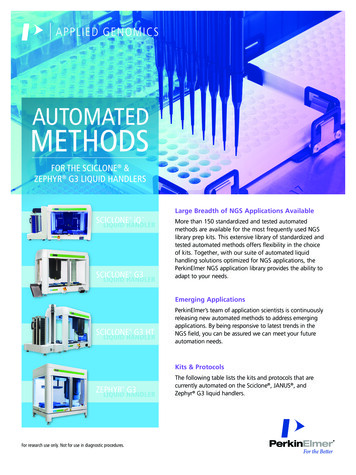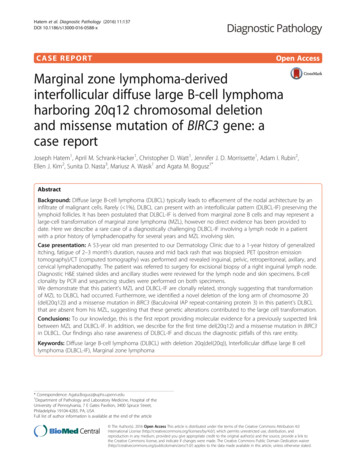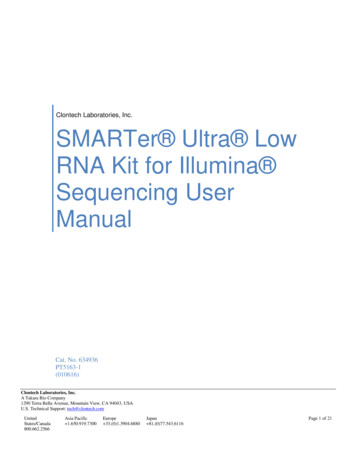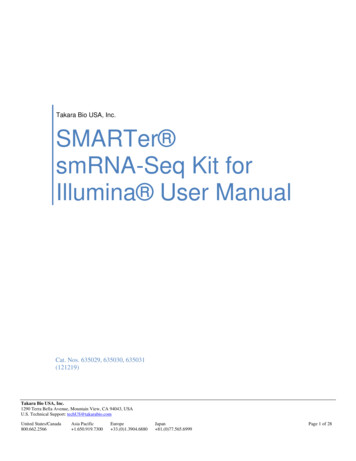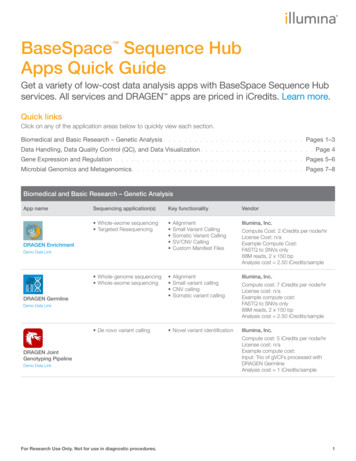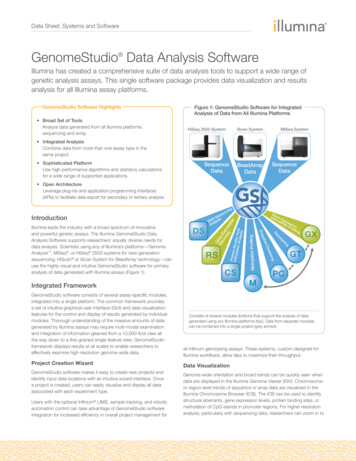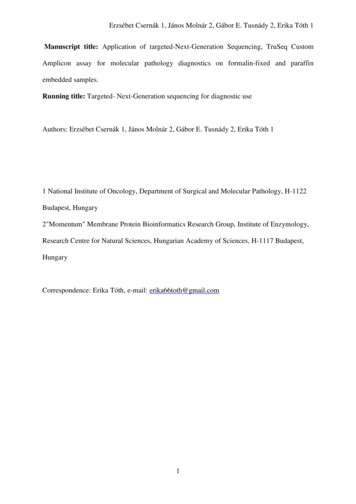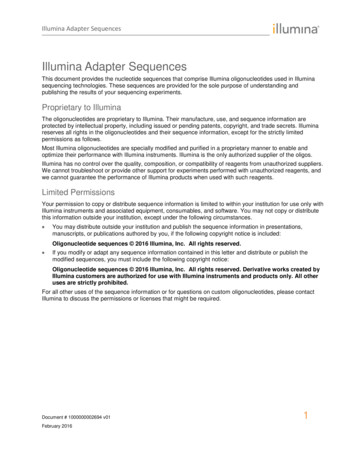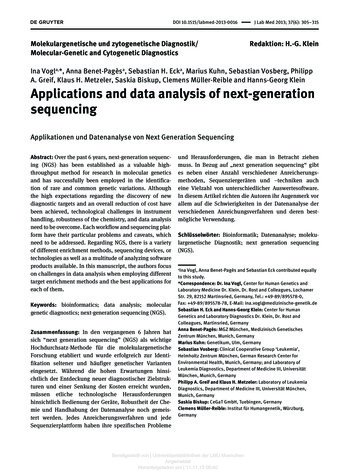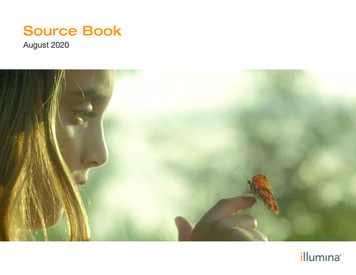
Transcription
Source BookAugust 2020
ILLUMINA’SMISSIONTo improve human health by unlocking the power of the genome.2020 Key Focus AreasENABLEBreakthrough GenomicsResearchIllumina Source Book - August 2020ACCELERATEClinical Adoptionof GenomicsADVANCETechnology Leadershipand Innovation3
TABLE OF CONTENTS05About Illumina06Our Culture07Corporate Social Responsibility09Ethics Advisory Board10Installed Base and Customer Examples11Illumina’s Business12History of Illumina’s Sequencing Innovation13Sequencing Systems and Key Applications14Sequencing Portfolio Details15Sequencing Workflow16Microarrays Overview17Illumina’s Clinical Strategy26Illumina Accelerator27Illumina Ventures28Key Corporate Transactions and Partnerships29Illumina Laboratory Services30Manufacturing Overview31Press Releases32Executive Team35Board of Directors37Revenue GrowthIllumina Source Book - August 20204
ABOUT ILLUMINAAs a startup, Illumina aspired to transform humanhealth. Our initial products enabled researchers toexplore DNA at an entirely new scale, helping themcreate the first map of gene variations associatedwith health, disease, and drug response. Everybreakthrough opened up a new world, andshowed us how much further there is to go.While the rate of progress is rapidly accelerating,we are only beginning to understand the clinicalsignificance of the genome. What causes acancer cell to mutate? What is the origin of apuzzling disease? Is it possible to prevent the nextoutbreak? Or safeguard the world’s food supply?These are just a few of the challenges that inspireus to push the boundaries of our imagination.Today we are a global leader in genomics –an industry at the intersection of biology andtechnology. At the most fundamental level, weenable our customers to read and understandgenetic variations. We strive to make oursolutions increasingly simple, more accessible,and always reliable. As a result, discoveries thatwere unimaginable even a few years ago are nowbecoming routine – and are making their way intopatient treatment.Illumina MilestonesGenomic MilestonesApril 1998Illumina is foundedOctober 1999Jay Flatley becomes President and CEOJuly 2000Illumina completes its IPOApril 2003Human Genome Project maps the human genomeFebruary 2005454 Life Sciences launches first NGS sequencerGenome AnalyzerAugust 2006Genomics and Personalized Medicine Act of 2006November 2006Illumina acquires SolexaNovember 200723andMe offers direct-to-consumer genetic testingMay 2008Genetic Information Non-Discrimination ActJanuary 2010Announces HiSeq 2000 and 10,000 genomeJanuary 2011DNA sequencing saves first childNovember 2013MiSeq Dx becomes first FDA-cleared NGS systemJanuary 2014Announces HiSeq X and 1,000 genomeNicholas VolkerJuly 2016Francis deSouza becomes President and CEOJanuary 2017Introduces NovaSeq with path to 100 genomeApril 2017Launches CE-IVD marked VeriSeq NIPT SolutionJanuary 2020Introduces NextSeqTM 2000 with Blue/Green SBSand super resolution opticsIllumina Source Book - August 2020December 2018Genomics England completes sequencing100,000 genomes5
OUR CULTUREOverviewIllumina is committed to building, innovating, andwinning as an inclusive team. With more than7,700 global employees and 20 offices across 8countries, our cultural values continue to be keyto the company’s success.Innovation is in our DNAStrategyIllumina will cultivate an agile, innovative workplace built to deliver exceptional performance.We will be recognized as a leading employer for top talent driven by our humanistic mission,culture of care, commitment to diversity & inclusion and development of extraordinary leaders.Culture of CareWe are relentless in the creationof great productsWe collaborate deeplyWe move fast and embracechangeTo ensure employees know how much they are valued, Illumina has implemented several policies todemonstrate our Culture of Care.Compassion and care time offMedical and sick leave supportFlexible time off100% of pay for 30 days100% base pay for 12 weeksPaid time off without accrual limitsHealth and Lifestyle allowanceUniversal variablecompensation programProgressive, personalizedbenefits100% of employees eligible forbonus payPrograms for fertility, expert secondopinions, and genomic resources 500 for health, lifestyleand well-beingNotable Awards Glassdoor Employees’ Choice Best Place to Work (2019) Computerworld Best Place to Work in IT (2019, 2018, 2017)We are open Corporate Equality Index’s Best Places to Work for LGBTQ (2020) Forbes’ The World’s Most Innovative Companies (2018, 2017, 2016, 2015, 2014) Forbes’ Most Just Companies (2019) Member of Bloomberg Gender-Equality Index (2020, 2019)Illumina Source Book - August 20206
CORPORATE SOCIAL RESPONSIBILITY: OVERVIEWBackgroundIllumina’s Corporate Social Responsibility (CSR) strategy focuses on the areas where we can uniquely impact the global community and the issues that matter mostto our business and stakeholders. We are dedicated to making a positive impact on humanity, not just through our technology, but also through our actions. Illuminahas identified three CSR Focus Areas, which are supported by two foundational elements. Our priorities and targets are aligned with the United Nation’s SustainableDevelopment Goals. For more information, please refer to Illumina’s first CSR report.Accelerating Access to GenomicsEmpower our CommunitiesEnvironmental SustainabilityWe are committed to connecting individuals,families, and communities to genomic solutions.We aim to share our time, talent, and technologywith the communities where we live and work.We invest in sustainable solutions across ourfacilities, products and business practices.Select 2030 Targets include:2020 Goal30%400 iHope CasesDecrease CO2 emission3Access for Patientsand Families100%2030 Targets50%Increase in the # ofparticipants touched by ourSTEM Programs175%Increase in renewable energy useReduction in packagingPartnership with:Access forCommunitiesAccess throughPartnerships andEducationIllumina Source Book - August 202012390%Of employees surveyed feelIllumina supports employeesgiving back to the community50%Of employees participate inour giving or volunteeringprograms290%Reduction in use of dry ice100%Strategic suppliers commit toreducing environmental footprint articipant target based on 2019 baseline of 306,170 participants touched by STEM. Participants defined as employees students educatorsP2019 participation rate was 40% Based on the concepts outlined by the Paris Climate Accord and Science Based Target methodology for 2 degree reduction using absolute percentreductions. Scope 1 and 2 emission reduction baseline and target include main campuses, commercial locations, and Illumina operated distributioncenters. Commercial locations utilized industry estimates if actual energy usage data was not available due to shared lease agreements, etc.7
CORPORATE SOCIAL RESPONSIBILITY: FOUNDATIONAL ELEMENTSOur PeopleEthics and GovernanceAt Illumina, we strive to foster an innovative workplace, powered by passionatepeople, to deliver on the transformative power of genomics. Our culture isfueled by openness, collaboration, caring, and innovation.Ethics and governance are foundational elements of our CSR program andhow Illumina does business. It ensures that our business principles align withour core values, ethical responsibilities, and legal obligations.Promoting Diversity and Inclusion through: Cultural competence Equal Opportunity Employee Resource GroupsCommitting to Zero Net Gap in Pay: 2019 confirmed zero net gap in pay Women represented 43% of total workforceand 45% of new hires8Employees certifiedto the Code100%Code of ConductBuilding, Investing, and Developing Talent:Illumina is committed to conducting its business in compliance with allapplicable laws and regulations, and with the highest ethical standards.Illumina provides training on the Code of Conduct for new and existingemployees, along with training on other company policies. Develop a robust, diverse pipeline of futuretalent through the iAspire InternshipsHuman Rights Professional development resources foremployees, including LinkedIn Learning Coaching and leadership development foremerging leaders and high potentialsProviding a Safe Workplace Environment: Global Environment, Health and Safety (EHS)engagement programs Prevention-based ergonomic resources Prevention and preparedness teams,including a Global Injury & IllnessPrevention ProgramIllumina Source Book - August 2020Code of ConductLanguagesIllumina acknowledges and respects the fundamental principles containedin the Universal Declaration of Human Rights and the United Nations GlobalCompact, and is committed to integrating these principles into our strategy,our culture, and our operations.Protecting PrivacyIllumina is committed to handling personal information according to applicablelaws and the following guiding principles: transparency, responsiblestewardship, ethical use, and accountability.Integrity Across our Supply ChainAll new suppliers are required to acknowledge the Supplier Code of Conductprior to onboarding.8
ETHICS ADVISORY BOARDIllumina is committed to building our company with integrity and ethical business behavior.What is Illumina’s EthicsAdvisory Board?Since 2008, Illumina convened anEthics Advisory Board (EAB) to ensurethat Illumina acts ethically and justlyin its business operations. The EABmeets quarterly to advise and providerecommendations regarding ethicalissues involving Illumina’s existing,emerging, and prospective products,services, and processes both from aresearch and clinical perspective. Thisincludes providing strategic advice toIllumina regarding emerging ethicalissues, policies, and regulations relevantto the genomics industry.Clement Adebamowo, BM, ChB,ScD, FWACS, FACSClement Adebamowo is Professor ofEpidemiology, Associate Director ofPopulation Science and Director for GlobalHealth Cancer Research at the GreenebaumComprehensive Cancer Center, and memberof the Institute of Human Virology at the University of MarylandSchool of Medicine. He was foundation chair of the NigerianNational Health Research Ethics Committee, Principal Investigatorof several NIH-funded genomics, cancer and bioethics researchand training projects including the Indigene Study, a project forimprovement of comprehension of informed consent for genomicethics in African communities that incorporates an online databaseof words related to genomics in local African languages.Leslie Biesecker, M.D.Les is a clinical and moleculargeneticist and is the chief of theMedical Genomics and MetabolicGenetics Branch at the National HumanGenome Research Institute (NHGRI)of the National Institutes of Health. Dr.Biesecker directs the ClinSeq project with goals to improvemedical care for patients and provide generalized knowledgeabout genetic disease. He is a member of the NationalAcademy of Medicine.Glenn Cohen, J.D.Glenn is a Deputy Dean and Professorof Law at Harvard Law School and theFaculty Director for the Petrie-Flom Centerfor Health Law Policy, Biotechnology, andBioethics. An award-winning academicand lawyer, Glenn’s work has appeared inleading publications and his amicus briefs have been discussedby the United States Supreme Court. His current researchfocuses on big data, health information technologies, researchethics, reproductive technology, and health policy.Illumina Source Book - August 2020Freda Lewis-Hall, MD,DFAPA, MFPMDuring her 35-year career in medicine,Dr. Freda Lewis-Hall has been on thefrontlines of health care as a clinician,educator, researcher, and leader in thebiopharmaceuticals and life sciencesindustries. Freda most recently served as Pfizer, Inc.’s ChiefMedical Officer and Executive Vice President until the end of2018 and as Chief Patient Officer and Executive Vice Presidentduring 2019. In these roles, Freda expanded outreach topatients, reshaped the focus on patient engagement andinclusion, improved health information and education, andamplified the voice of the patient within company culture anddecision-making.Nita Farahany, J.D., Ph.D.Nita is the Robinson O. EverettProfessor of Law & Philosophy atDuke University, and the Director ofDuke Science & Society Initiative.President Obama appointed Nita to thePresidential Commission for the Studyof Bioethical Issues in 2010 and she served until 2017. She isa leading scholar on the ethical, legal, and social implicationsof biosciences and emerging technologies, particularly thoserelated to neuroscience and behavioral genetics.Charmaine Royal, Ph.D.Charmaine is an Associate Professorof African & African American Studies,Biology, Global Health, and FamilyMedicine & Community at DukeUniversity. She directs the Center onGenomics, Race, Identity, and Differenceand the Center for Truth, Racial Healing, and Transformationat the Social Science Research Institute. Charmaine’smain academic interest is in addressing root causes andimplementing sustainable solutions regarding problems of raceand racism in research, healthcare, and society.9
INSTALLED BASE AND CUSTOMER EXAMPLESA leading academic researchcenter using genomics toadvance the understandingand treatment of humandisease.Develops and sells a portfolioof genomic tests, including theFDA-approved FoundationOneCDx that detects geneticmutations and TMB.A premier center of genomicdiscovery, leading collaborationsacross the globe.A global leader in geneticdiagnostics for rare hereditarydiseases with testingsamples from over 125different countries.FIND India focuses onevaluation and demonstrationstudies of new diagnostictools that FIND co-develops,supporting the RevisedNational TuberculosisControl Program by buildingprogrammatic capacity forgenome sequencing in India.Discovers genealogy andgeographic origins. Samplesare processed by Illuminaand Quest Diagnostics.A technology companythat enables physicians todeliver personalized cancercare for patients throughits platform. Also providesgenomic sequencingservices and data analysisto empower physicians.A Chinese prenatal genetictesting and diagnosticscompany that has apartnership with Illumina forCFDA approved NIPT kit.Over 15,000* Systems Placed GloballyA personal genomicscompany that has a platformproviding personal genetictesting and analysis services.Announced a collaborationto equip its labs with Illuminamicroarray technologies.SELECT CUSTOMERS BY SEGMENTResearchTranslationalClinicalConsumerNote: Select customer logos and descriptions are included with their respective approvals.*Excluding HiSeq, this includes all systems that have been shipped to customers and may include some decommissioned or inactive systems.Illumina Source Book - August 202010
ILLUMINA’S BUSINESSIllumina’s revenues are comprised of two distinct genomic technologies: sequencing and microarrays.SEQUENCINGMICROARRAYS11%When to choose sequencing? For analyses of large panels, exomes,or whole genomes When the targeted DNA region is notfully known When high coverage or “deepsequencing” is required When a wide range of applications,from basic science to clinicaldiagnostics, is requiredWhen to choose microarrays?Revenue89% For interrogation of known variants(e.g., single nucleotide polymorphisms) For discovery and association incommon variations (e.g., polygenicrisk scores, genome wide associationstudies) When an answer is required quickly When lower cost than sequencing isrequiredNote: Revenue for Q220.Illumina Source Book - August 202011
HISTORY OF ILLUMINA’S SEQUENCING High-throughputHiSeq 2000HiSeq 2500HiSeq X TenHiSeq 3000/4000NovaSeqEnabled the 10,000 genomeAllowed forRapid Run Modeto meet higherthroughput needsEnabled the 1,000 genomeSignificantlyincreased dataoutputMost powerfulsequencer that isexpected to enablethe 100 genomeNextSeq 500NextSeq 550NextSeq 550Dx2NextSeq1000/2000First benchtop tobe powered by2-channel SBSCombinedmicroarrayscanningwith NGSFDA-regulated andCE-IVD marked forclinical researchand IVD assaysFirst system withsuper resolutionoptics and Blue/Green SBSMid-throughputLow-throughputMiSeq MiSeqDx1MiniSeqiSeq 100Benchtopsequencer, gavemore scientistsaccess to NGSThe first NGSplatform to beFDA cleared forIVD testingMade NGS simpler(integrated reagentcartridge), smaller,and more accessibleMost compactNGS system forunder 20kI n August 2018, MiSeqDx sequencing system received the approval certificate from the China National Drug Administration (CNDA) and in January 2020, received approval from Japan’s Pharmaceuticalsand Medical Device Agency (PMDA) as a Class 1 medical device.2In October 2018, NextSeq 550Dx received approval from Japan’s PMDA as a Class 1 medical device.1Illumina Source Book - August 202012
SEQUENCING SYSTEMS AND KEY APPLICATIONS OVERVIEWLarge WGS(human, plant,animal)Small WGS(microbe, virus)ExomeSequencingTargeted GeneSequencingWholeTranscriptomeSequencingGene ExpressionProfiling withmRNA-SeqTargeted GeneExpressionProfilingHigh-throughputNovaSeq Broadest range of applications Enables lowest price per sampleHiSeq X Five/Ten Enabled the 1,000 Genome HiSeq 2500/4000 Production-scale sequencingMid-throughputNextSeq 1000/2000 Incorporates blue/green SBS and superresolution opticsNextSeq 500/550 Flexible output options (mid and high) Low-throughputMiSeq First benchtop sequencerMiniSeq 1 day turnaround timeiSeq 100 Most affordable sequencer Note: Only key applications highlighted, which does not reflect each system’s entire set of capabilities.Illumina Source Book - August 202013
SEQUENCING PORTFOLIO DETAILSInstrumentPriceApprox Price/GbMax Outputper Run1Max ReadLengthMax Readsper Run1Time onMax RunsNovaSeq 6000 with S4 985K 4.806 Tb2 X 150 bp20 billion 44 hrsNovaSeq 6000 with S2 985K 7.702 Tb2 X 150 bp6.6 billion 36 hrsNovaSeq 6000 with S1 985K 10.501 Tb2 X 150 bp3.2 billion 25 hrsNovaSeq 6000 with SP 985K 10.50800 Gb2 X 250 bp1.6 billion 38 hrsHiSeq XNA 81.8 Tb2 X 150 bp6 billion 3 daysHiSeq 4000NA5 251.5 Tb2 X 150 bp5 billionHiSeq 2500NA6 381 Tb2 X 125 bp2NextSeq 2000 with P3 335k 20300 GbNextSeq 1000 with P2 210k 30NextSeq 550 275KPull-ThroughRangeFlow atterned2Patterned2Patterned2NAPatterned2 3.5 daysNAPatterned44 billion 60 hrs2NARandom42 X 150bp1 billion 48 hrsNAPatterned2NA120 Gb2 X 150 bp400 million 29 hrsNAPatterned2NA 41120 Gb2 X 150 bp400 million 30 hrsNARandom2 3,600 99K 10815 Gb2 X 300 bp25 million 56 hrs 40K- 45KRandom4 7,400MiniSeq 49.5K 2257.5 Gb2 X 150 bp25 million 24 hrs 20K- 25KRandom2 1,100iSeq 19.9K 5211.2 Gb2 X 150 bp4 million 19 hrsNAPatterned1 860High-throughput5 1.1M- 1.2M 920 1,3004Mid-throughputLow-throughputMiSeqAssuming two flow cells per run on NovaSeq and HiSeq Series Systems.Rapid run mode.As of end of 2019. Excluding HiSeq, this includes all systems that have been shipped to customers and may include some decommissioned or inactive systems.4Combined HiSeq family.5 HiSeq X and 4000 instruments are no longer available for sale, but instruments and reagents will be supported through March 31, 2024.6 HiSeq 2500 instruments are no longer available for sale, but instruments and reagents will be supported through February 28, 2023.123Illumina Source Book - August 202014
Librarypreparation LibraryCluster growthSEQUENCINGpreparationWORKFLOWCluster growthSequencingSequencingDNA ( 1 µg) DNA ( 1 µg)1 Library preparation Before sequencing can take place, asequencing library 1needs to be2created1which contains the DNA (or RNA) ofinterest to the experiment.4-channel4-channel Duringthe library generation process,adapters will be added (usually via aprocess called ligation) onto both ends1of the molecules of1interest. 2 These adapters are what enable clustergeneration as well as 2-channelwhat provide a2-channelunique barcode to uniquely identifylibraries that may have been pooledtogether for sequencing. As such, many libraries may be pooledtogether to enable efficient use of theoutput of a single sequencing run.Cluster Growth/2 GenerationImaging Imaging Once prepared, libraries (or pools ofinto3 loaded 54 a flow cell3 2libraries)4are65 inpreparation for sequencing. Before clustering, libraries need tobe denatured. Most Illumina systemsuse NaOH for library denaturation;however for iSeq, this process is2345inside3 automated4 and is performed56the cartridge by the sequencer. Once denatured, DNA fragments canbe captured on surface-bound oligosthat are complementary to the libraryadaptors. Each fragment is thenamplified into distinct, clonal clustersthrough bridge amplification.What is a flow cell?A flow cell is a glass slide with fluidic channels orlanes, where the sequencing chemistry occurs.Illumina Source Book - August 20203 Sequencing Once a flow cell is clustered, sequencing can6commence. First, all the molecules within acluster are orientated into the same directionTGCTACand denaturedto allowthe sequence primerTGCTAC(complementary to the adapters) to anneal.Base callingBaseannealed,calling a polymerase With the primerenzyme is introduced and begins incorporating6fluorescently labeled nucleotides (ddATP,ddGTP, ddCTP, ddTTP)which areTGCTACTGCTACcomplementaryDNA bases of interest in theclusters.Base callingBasearecalling These ddNTPsspecially designed to haltsynthesis after a single base is incorporated toensure the synthesis of new strands is syncedand the same length at the end of each cycle. At this point, the instrument excites thefluorescent labels on the newly incorporatednucleotide and captures an image of the flowcell. This image allows identification of the firstbase in the cluster.4 Data Analysis During sequencing, primary analysisis done on the instrument. Thisconverts the images of the clustersinto intensities and base calls. Post sequencing, secondaryanalysis begins. This involvesadditional software to generatealignments and then variantdetection. Illumina offers thiscapability via its BaseSpaceSequence Hub. Once the variants have beenidentified during secondaryanalysis, tertiary analysis allowsfor annotation, filtering, andinterpretation. Illumina sequencing uses reversible terminationthat can turn a ddNTP into a regular dNTP,which allows the sequencing process to repeatand proceed one nucleotide at a time instead ofbeing permanently halted. This process is repeated continuously, allowingidentification of one base of the cluster eachtime the process repeats.15
MICROARRAYS OVERVIEWBackgroundCase Study1:What is a microarray?Who?A microarray, or array, is a DNA chip thatcan be used to “genotype” multiple regionsof a genome.Neogen genotypes more than 10,000 samples per day for livestockproducers worldwide.What is genotyping?Neogen developed dozens of custom Infinium arrays to evaluate close to50k markers, which allows livestock producers and breeders to selectivelybreed for superior animals.The process of determining genetic variantsin the genetic make-up of the DNA.How are array technologies used?Array technologies continue to be used in awide range of applications, including: Consumer genomics and health screening Agrigenomics Research (e.g., methylation testing)Genotyping AdvantagesPer sample costHow do they use microarrays?What’s the impact?This is especially important when the desired increases in geneticimprovement are for traits that are not highly heritable, such as daughterpregnancy rate, for selecting the best dairy cattle bulls. The results for animalbreeders include the elimination of genetic-based diseases.Sample throughputKey MicroarraysIllumina’s portfolio of arrays can analyze from 100 to 5M variants.Select arrays below:Robust datamanagement solutionsOverviewiScanThe Infinium workflow is run on theiScan system and is a highly robust,highly scalable end-to-end solutionwith automation compatibility. Starter Kit configurations to support the workflowand meet throughput targets. Optional Tecan liquid handling robot andAutoloader to support walk-away capabilities. Optional Infinium LIMS to implement positivesample tracking and workflow enforcement.Global ScreeningArray (GSA)Infinium XTMethylationEPIC BeadchipBuilt for consumergenomics and clinicalresearch in translationaland precisionmedicine effortsCustomizable withflexible content, idealfor agrigenomicsand low plexityconsumer genomicsComprehensivegenome-widemethylation coveragefor research of geneticdisease and oncologyFast FactStatistical powerMature technologyIn Q220, microarrays represented about 11% of revenues.The case study is included with customer approval.1Illumina Source Book - August 202016
ILLUMINA’S CLINICAL STRATEGYEnable InnovatorsBroaden UseAccelerate ReachBy providing industry-leading technologysolutions, we enable our customersto continue to innovate and deliverclinical content, increase awareness,and drive adoption.By developing distributable IVD kits inselect clinical markets, we will broadenthe reach of clinical sequencing. Thiswill lower the barrier to adoption andenable labs of all sizes to run NGS-basedsamples in-house.By partnering with leading clinicalcompanies, we can accelerate patientaccess and increase impact. Workingtogether, we will expand the clinical menuavailable on Illumina Dx platforms.Illumina Source Book - August 202017
FOCUS AREA: ONCOLOGYThe NeedPatient JourneyNotable DevelopmentsAs cancer prevalence and costs rise, the needfor effective patient stratification is drivingresearch efforts to identify biomarkers anddevelop companion diagnostics.Overview for clinical testingJan 2019: Illumina announces its TruSight Oncology 500assay has been granted Breakthrough Device Designation.Illumina is seeking FDA approval of the assay as a CDx. The number of new cancer cases is expectedto increase to 24M per year by 20301. In 2017, the national economic burden ofcancer care in the US was estimated at 137B2.Determinehereditary riskthrough plasma/saliva samplesusing NGS panels.Multi-target TestMar 2019: MolDx publishes draft LCD to expand coverageof NGS-based LDTs to all advanced solid tumors and selecthematological cancers.April 2019: Prostate cancer guidelines recommend NGS forMSI testing and as an option for germline testing.The goal is to go from single tests to comprehensive,multigene tests to fuel precision medicine.PatientMar 2019: Guardant Health’s NILE study met its primaryendpoint of detecting a similar number of targetablebiomarkers in non-small cell lung cancer patients. The medianturnaround time was also shorter (9 days vs 15 days).HereditaryDispositionScreeningScreen forasymptomaticpatients withplasma-basedsamples.The DrugMay 2019: GRAIL receives Breakthrough DeviceDesignation for its multi-cancer screening test.Jan 2020: MolDx finalized LCD for NGS-based LDTs, bothtissue and liquid, in patients with advanced solid tumors andhematological cancers.Target 1Key DriversTarget 2Target 3StrategyIllumina is committed to enabling ourcustomers and industry partners to innovateon our technologies. Our goal is to provideeach customer, ranging from research totranslational to clinical, with targeted solutionsthat move NGS into the standard of care.International Agency for Research on Cancer as of September 2018.2NIH National Cancer Institute as of February 2018.1Illumina Source Book - August 2020Therapy SelectionBasic ResearchReceive optimizedcancer treatmentwith companiondiagnosticsolutions.The discovery process has only just begun. Basicresearch is needed to better understand the biology ofcancer and discover treatment.Monitor efficacyand diseaseprogressionCurrently usingimaging, but NGSpanels couldcomplementand eventuallybecome viablealternatives.NGS DemocratizationBy enabling service providers and regulatory approvedstandardized distributable kits, Illumina is enablinggreater access to life enhancing tools for patient care.Regulatory and ReimbursementRegulatory approval and reimbursement coverage ofboth small and large panels remain important for theuptake of companion diagnostics.18
PRODUCT OVERVIEW: TRUSIGHT ONCOLOGYOpportunityOverviewTruSight Oncology 500 is a next-generationsequencing assay for research use that enablescomprehensive genomic profiling (CGP). It combinesvariant calling, TMB and MSI into a single test thatprovides reproducible results and works with lowsample input.Illumina TSO500TypeTissue-based and ctDNAPanel size1.94Mb# Genes tested523Sample input40 ng or 5 FFPE slidesTurnaround time3-4 daysRUO Launch DateJanuary 2019100 million18 million10 millionpeople living with cancerworldwide in 20171new cancer casesworldwide in 20182cancer-relateddeaths in 20182Unfortunately very few tumors are sequenced (for example, only 8% of tumors have been sequenced globally).Combined with the growing number of clinical trials for immuno-oncology and approved immuno-therapies, CGPis expected to increasingly play a role for cancer treatment.Products In DevelopmentCompanion DiagnosticIllumina is actively partnering with pharma companies to develop a companion diagnostic (CDx) assay based onTSO500 content (planned to be branded as TSO Comprehensive). The FDA has granted this assay BreakthroughDevice Designation, which means the review process will be expedited.Liquid BiopsyComprehensive Genomic Profiling BenefitsCGP has several benefits over single or “hotspot” tests: Requires less sample input Allows targeting of a growing number of biomarkers inone testIllumina has developed a version of TSO500 specifically for liquid biopsy samples. This TSO500 ctDNA assayis expected to be used when there is not enough sample tissue, or as a complementary assay for the tissueassay results.As part of the development process, we partnered with Frederick National Laboratory (FNL) to establish the clinicalutility for liquid biopsies in oncology testing. Using the TSO500 ctDNA, Illumina will work with FNL to: Enables a hypothesis neutral approach as opposed toordering a test for each hypothesis Perform a full analytical validatio
Illumina Source Book - August 2020 6 Overview Illumina is committed to building, innovating, and winning as an inclusive team. With more than 7,700 global employees and 20 offices across 8
